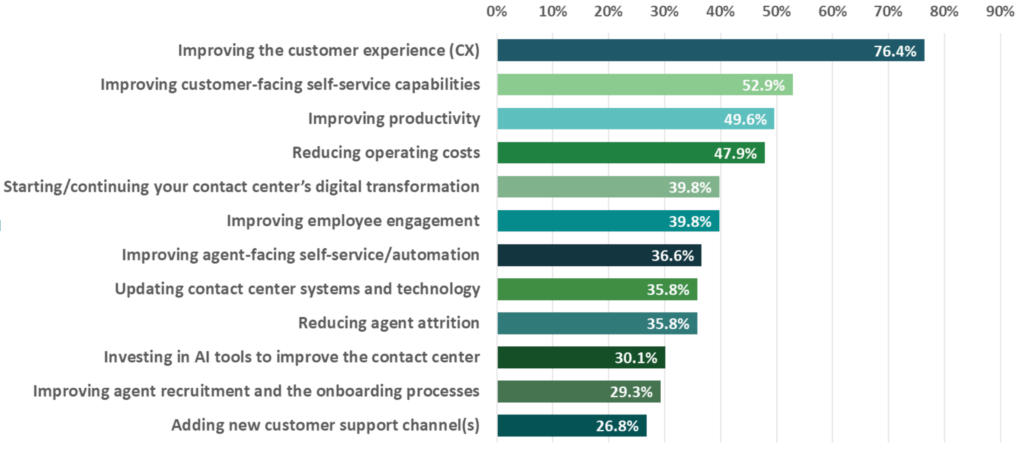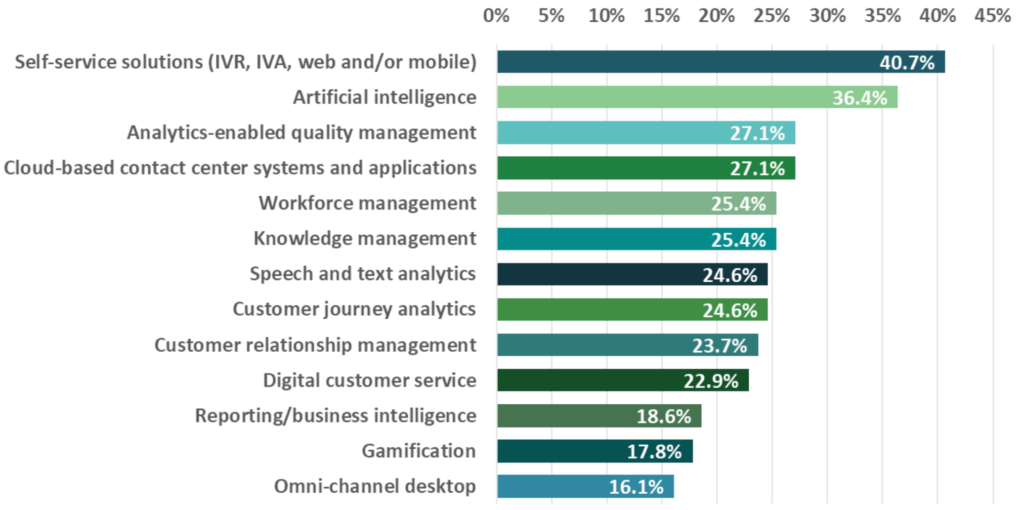2022: The Year Dedicated to Improving the Customer Experience
On an annual basis, in the November/December time frame, DMG Consulting (DMG) conducts a worldwide survey of contact center and enterprise executives and managers to identify their top operational and technology investment priorities for the coming year. In this year’s survey, DMG identified the direction organizations are taking and enhancements they are planning to make to improve their overall customer experience (CX) and performance of their contact centers.
2022 Top Contact Center Priorities/Goals
Executives and service leaders worldwide are dedicated to improving the customer experience (CX), as reflected by the very positive 76.4% of survey participants who identified this as their top priority (or goal) for calendar year 2022. See Figure 1. The rest of the items selected are essentially the tactics companies plan to use to improve the CX. This includes: improving customer-facing self-service capabilities (52.9%), improving productivity (49.6%), reducing operating costs (47.9%), starting/continuing the contact center’s digital transformation and improving employee engagement, which tied for 39.8%, improving agent-facing self-service automation (36.6%), and more. The 12 goals shown in Figure 1 make it clear that enterprise and contact center leaders are concentrating on enhancing both the customer experience and employee engagement, underscoring the growing appreciation of the role that agents play in the service experience. (Twelve items are in the list because there were two ties.)
Figure 1: Top 10 Contact Center Priorities for 2022

2022 Top Contact Center Technology Investments
Enterprises and organizations around the world understand the importance of delivering an outstanding CX, but this remains a hard goal to achieve due to many factors, not least of which is changing customer expectations. Most of the technology investments that companies plan to make in contact center systems and applications are intended to help companies “do right” by both their customers and employees while also improving their bottom line. This is proving to be difficult, as so much is changing in the servicing world in the last couple of years. Companies are striving to strike a healthy balance between their investments in digital transformation, self-service, artificial intelligence (AI), automation and analytics. It helps that there is a great deal of overlap among these investments, but there are a lot of technology investments contact centers need to make during 2022.
Figure 2 shows the top 10 system investment priorities for contact centers in 2022. As expected, these investments are intended to help leaders deliver on their top contact center and servicing goals for the year. The number-one system investment priority for 2022 is self-service solutions (interactive voice response (IVR), intelligent virtual agent (IVA), web and/or mobile), as selected by 40.7% of survey participants. Investments in AI came in second (36.4%). Analytics-enabled quality management and cloud-based contact center systems and applications tied for third place (27.1%). Investments in workforce management (WFM) and knowledge management were selected by the same percentage of survey participants, 25.4%, in fourth place. Speech and text analytics (also known as interaction analytics) came in fifth (24.6%). Customer journey analytics, a system needed in the contact center as well as throughout an enterprise to capture and understand what customers are doing and how they feel about each experience, tied for fifth place (24.6%).
Figure 2: Top 10 Contact Center Technology Investment Priorities for 2022

Where Will Contact Center Employees Work in 2022
The great debate continues about where contact center employees are going to work in 2022. Here’s how it is playing out, according to the survey results: 11.3% of companies plan to bring their contact center staff back to the office (if they are not already there). 20.7% of companies plan to use a full work-at-home (WAH) staffing model. And the vast majority of contact centers, 68%, are going to offer their employees a hybrid model, which typically means a few days at home and one or two days in the office. The “Great Resignation” in the US, which is also impacting staffing in a few other countries, is having a strong effect on contact centers. Contact center agents are making it clear to their employers that they want to be treated with respect, be properly compensated, and have more career opportunities, at the same time as they want scheduling flexibility. These demands are driving a major round of investment in WFM solutions.
Final Thoughts
The survey results make it clear that there are many positive changes happening in contact centers. Improving the CX is the top objective, and there is a growing appreciation that the only way this can be achieved is by having a more engaged and satisfied staff. Companies are acting on this goal by prioritizing the inclusion of AI and automation in their contact center applications, which is a win for customers, agents and the company’s bottom line. Click here to see the full Report on Customer Experience, Contact Center and Servicing Priorities and Investment Plans for 2022.
